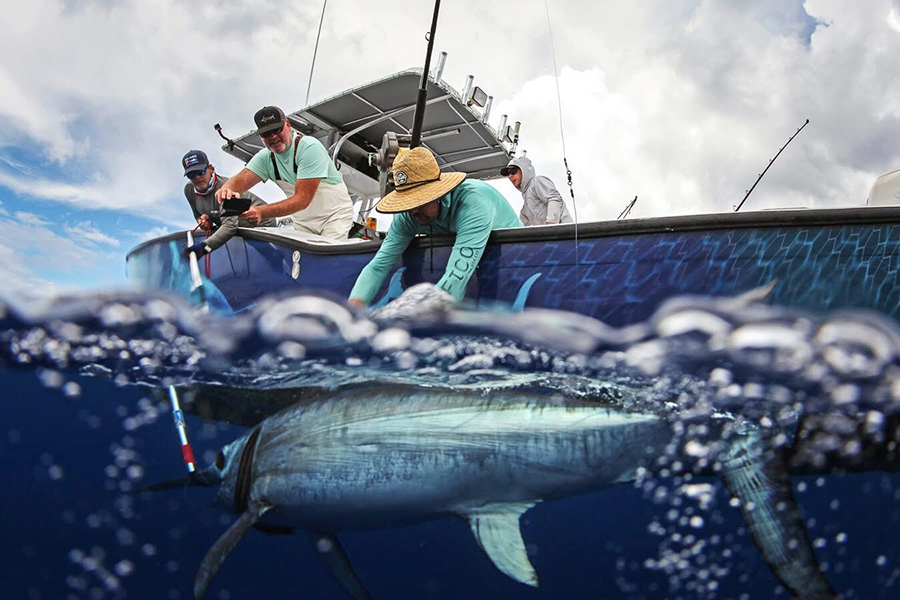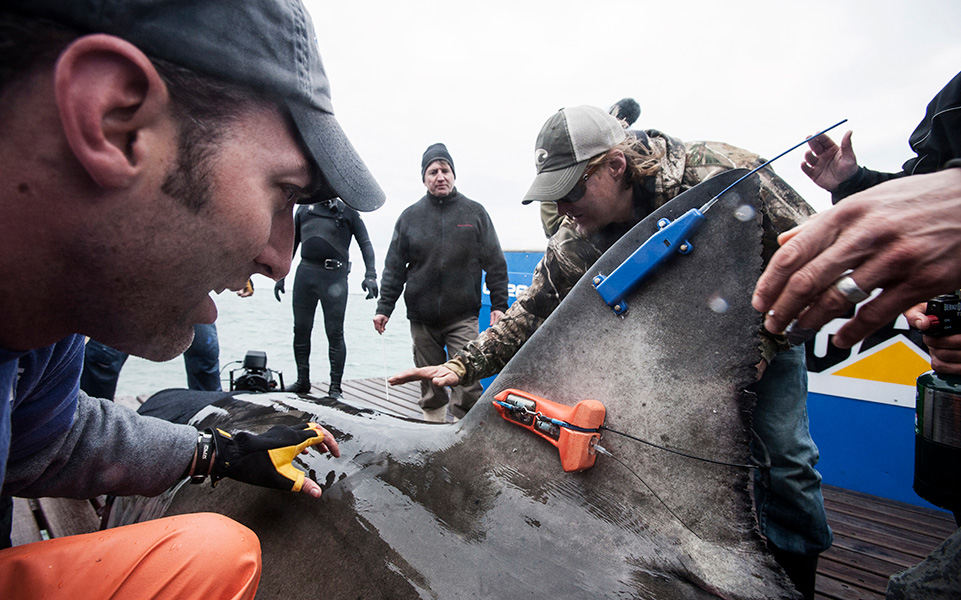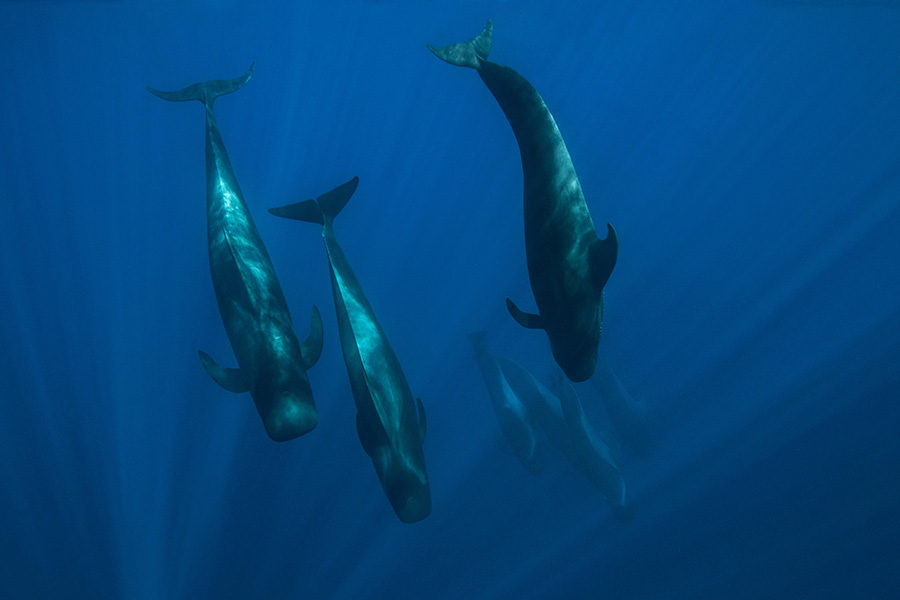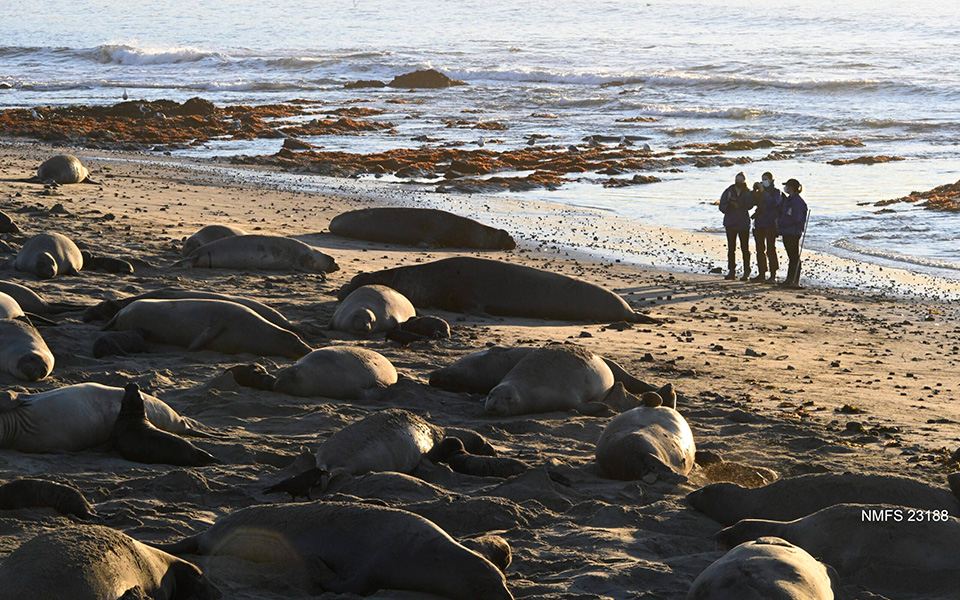There’s only one word for it: indescribable. “It’s one of those awesome experiences you can’t put into words,” says fish ecologist Simon Thorrold. Thorrold is trying to explain how it feels to dive into the ocean and attach a tag to a whale shark — the most stupendous fish in the sea. “Every single time I do it, I get this huge adrenaline rush,” he says. “That’s partly about the science and the mad race to get the tags fixed. But part of it is just being human and amazed by nature and huge animals.”
Whale sharks are one of a select group of large marine animals that scientists like Thorrold, of the Woods Hole Oceanographic Institution in Massachusetts, have signed up as ocean-going research assistants. Fitted with electronic tags incorporating a suite of sensors, tracking devices and occasionally tiny cameras, they gather information where human researchers can’t. They have revealed remarkable journeys across entire oceans, and they have shown that diving deep is pretty much ubiquitous among large marine predators of all kinds.
Many regularly plunge hundreds and sometimes thousands of meters — to depths where the water can be dangerously cold and short of oxygen, there’s little or no light except for the flickers and flashes of bioluminescent organisms, and the pressure is immense, putting some animals at risk of fatal decompression sickness.
To function at such depths, deep-diving species have evolved an array of anatomical and physiological adaptations — thick, insulating blubber, for instance, or blood vessels transformed into heat-exchange systems, collapsible lungs and oxygen-storing muscles, and ultra-sensitive eyes, to name but a few. But what drove these great predators to acquire their remarkable diving skills?
For most biologists, the answer is a no-brainer: Food. Yet that’s been remarkably hard to prove. After decades of tagging studies, there’s enough circumstantial evidence to be confident that many top predators do dive deep in search of prey. But even now, only one species has been seen in action. The northern elephant seal (Mirounga angustirostris) is now something of a superstar, thanks to a pioneering series of mini-movies featuring its own snout and whiskers and a supporting cast of deep-sea fish and squid.
Food, though, might not be the deep sea’s only attraction, says Thorrold, coauthor of an article that examines the motivation of diving predators in the 2022 Annual Review of Marine Science. Dives and diving behavior vary: Some animals dive many times an hour, others sporadically. Most stick to depths between 200 and 1,000 meters, a region officially named the mesopelagic but better known as the twilight zone; others plunge far deeper. The shapes of dives hint at more than one function, too. A quick downward plunge and equally steep ascent, for instance, suggests a different purpose from a long, slow, flat-bottomed dive. “If the same individual does different types of dive at different times,” says Thorrold, “then that’s good evidence they are for different purposes.”
There is no shortage of suggestions for what those purposes might be. Deep, dimly lit waters could provide refuge from other predators; somewhere to cool an overheating body; navigational cues for those able to detect them; even a long-distance communication channel. “All these ideas are in play,” says Thorrold. “The fact we can’t rule out any of them reflects how mysterious a lot of these large pelagic animals are to us.”
Almost every group of ocean-going vertebrate includes some species adapted for diving deep. Most visit the twilight zone, but many dive farther. Cuvier’s beaked whale holds the record for a mammal (2,992 meters). Whale sharks are the record-holding fish (1,928 meters).
Welcome to the deep-sea diner
Diving deep has evolved in nearly every type of ocean-going vertebrate. Big bony fish, such as tuna and swordfish, do it. Cartilaginous sharks and rays do it. So, too, do air-breathing animals — penguins, sea turtles, toothed whales and seals, all of which reach extraordinary depths on a single breath.
Most dive as far down as the twilight zone, where the dim light from above rapidly dwindles to nothing. Some go into the blackness of the midnight zone, the bathypelagic realm between 1,000 and 4,000 meters. The current record-holder is Cuvier’s beaked whale: In 2014, one tagged whale reached 2,992 meters off the coast of Southern California. The record for a fish is held by a whale shark that reached 1,928 meters in the Gulf of Mexico in 2010.
Biologists of times past would never have dreamt that deep waters would have much to offer a top predator. In the 19th century, naturalists believed that little lived deeper than 500 meters or so — but in the 1940s, Navy sonar operators discovered the deep scattering layer, a zone where their sonar bounced off multitudes of mesopelagic organisms. This food-packed layer moved up and down as fish and tiny invertebrates migrated toward the surface to feed at night and retreated to the relative safety of deep water during the day.
The ocean’s twilight zone turned out to be an unexpectedly well-stocked larder, filled with weird and wonderful gelatinous creatures, muscular squid, the ubiquitous and highly nutritious lanternfish and the spiny-toothed bristlemouth, reckoned to be the world’s most abundant vertebrate. In 1980, fisheries scientists estimated the global biomass of mesopelagic fish at a billion metric tons, based on surveys with nets. In 2014, a study based on acoustic surveys put the figure seven to 10 times higher.
As yet, there is no global estimate of the life in the chill, black depths of the midnight zone, but a study in the waters over the Mid-Atlantic Ridge found an even greater mass of potential prey there. “Diving to forage makes sense if deep water is where the biomass is,” says Thorrold.
Female northern elephant seals equipped with smart video cameras have produced the first — and so far, only — film clips of a deep-sea predator in action. These clips show seals making a grab for deep-sea fish.
CREDIT: K. YOSHINO ET AL / JOURNAL OF EXPERIMENTAL BIOLOGY 2020
Until very recently, though, all the supporting evidence for foraging was circumstantial. Mesopelagic fish, squid and crustaceans turned up in the stomachs of tuna, swordfish and blue sharks, while sperm whale stomachs contained the indigestible beaks of deep-sea squid, including the giant squid Architeuthis. Tagging studies consistently put predator and prey in the same place at the same time. They’ve shown that large fish and mammals regularly and repeatedly dive into the deep scattering layer, and often dive deeper during the day when potential prey has migrated further into the gloom. Some tagged tuna and swordfish track precisely the daily migration of potential prey.
With the development of increasingly sophisticated tags, biologists are building an ever more detailed picture of what these animals are doing in the depths. Attached to fins and flippers, heads and jaws, they collect and store a wide range of data over many months. Tags that include sensors for pressure, temperature and light have enabled researchers to reconstruct movements through the water and the depth and profile of dives. The past few years have seen the emergence of innovative extras — accelerometers that log the twisting and turning of a head, sensors that detect the movement of jaws, sound-detecting hydrophones, even a smart video camera that shoots only moments worth recording.
Getting these tags onto top predators is hugely challenging. “Whale sharks are rare and elusive, but we’ve now gotten a good number of tags on them,” says Thorrold. Fearsome sharks like the great white are challenging for a different reason. Free diving is not an option, and if you want to tag the creature’s dorsal fin, you need a ship with a hydraulic platform to lift the shark aboard, where the operation can be carried out safely.
Swordfish are particularly tricky to tag. They are hard to find, unpredictable and dangerous, as Thorrold’s coauthor Peter Gaube, an oceanographer at the University of Washington, can testify. “When you do catch one, you have to hold it alongside the boat and try to fix the tags while it tries to whack you or bash a hole in the boat with that razor-sharp sword.”

Unpredictable and dangerous, swordfish are particularly hard to tag, making it difficult to follow their travels into the deep. With help from expert swordfish wranglers, oceanographer Peter Gaube (in the hat) successfully attaches a tag to a swordfish off the coast of Florida in 2019.
CREDIT: STEVE DOUGHERTY
The devil’s in the details
Some of the best evidence of foraging has come from unexpected quarters — such as the Chilean devil ray (Mobula tarapacana), a huge but mysterious fish with a “wingspan” of almost4 meters. Most sightings of Chilean devil rays come from surface waters, where they often seem to bask in the sun, a habit that led to the assumption that they prefer life nearer the surface.
Curious to know more about them, Thorrold and colleagues made two tagging expeditions to the Azores, where large numbers of devil rays gather around the Princess Alice seamount for a few months each year. In 2011, the team tagged four rays; in 2012, they tagged 11 more. The tags logged the rays’ movements for up to five months before transmitting their data back to Woods Hole.
The results were staggering: Not only did the devil rays travel thousands of kilometers at a cracking pace, they frequently plunged 1,000 meters and more. The deepest recorded dive was 1,896 meters. The sun-soaking, surface-dwelling rays are anything but: They are among the deepest diving fish in the sea, and everything points to food as the attraction.
Most of the devil ray dives had an unusual stepwise profile. “They dive deep, then level for a bit, come up a bit and level again, and so on,” says Thorrold. “If you look at sonar, it seems they stop off where there are thin but dense layers of prey. We haven’t been able to see what they are doing, but this is strong evidence that they are foraging.”
That would explain why Chilean devil rays have a network of well-developed blood vessels in their brain cavity, much like that found in some deep-diving sharks, where it functions as a heat-exchange system to prevent the brain from growing too cold. Biologists had always wondered why a fish that lives in the sunlit upper waters of the ocean would need one. “This is more evidence that devil rays forage at depth and so need to keep their brain and sensory systems active in the cold,” says Thorrold.
As for basking in the sun — that, Thorrold suggests, is to warm up before and after deep dives.
Like devil rays, tag-toting sharks have been providing intriguing glimpses of behavior that lends more weight to the idea that they hunt in deep waters. Most of what we know of sharks comes from studies in coastal waters — yet many migrate vast distances across the open ocean. Away from the seal-studded coasts, prey becomes patchy and thinly spread. So how do big sharks get enough to eat?

Lydia the great white shark had two tags fitted to her dorsal fin in 2013. The orange tag recorded depth and water temperature every five minutes; the second tag reported her location via satellite whenever the fin broke the surface. Lydia’s movements first revealed how some sharks dive through warm eddies to reach deeper water to find prey.
CREDIT: OCEARCH / ROB SNOW
Recent research suggests that some sharks have a smart strategy to gain access to the ocean’s biggest buffet. Data from two great white sharks and 15 blue sharks as they traveled the North Atlantic showed that they take advantage of eddies, swirling masses of water that break away from the Gulf Stream. Eddies that spin off the northern edge of the Gulf Stream trap warmer water from the south; eddies formed from the southern edge carry cool water southward. Both white and blue sharks showed a marked preference for warm-hearted eddies.
These warm eddies contain a higher density of mesopelagic prey, acoustic surveys have shown. And with anomalously warm water extending hundreds of meters, sharks can forage much deeper and for longer. “Warm eddies can provide sharks access to deeper food sources that would otherwise be inaccessible,” says Gaube, a coauthor of the research.
Sound and vision
The nearest thing to proof that marine predators evolved extreme diving skills to exploit a rich but otherwise inaccessible source of food is coming from animals wearing tags with extra bells and whistles.
In the case of the short-finned pilot whale (Globicephala macrorhynchus), that meant a sound recorder. Pilot whales emit a series of clicks while they hunt, listening for echoes bouncing off prey. As they close in on a target, the clicks come so thick and fast they merge to a buzz. Natacha Aguilar de Soto, a marine biologist at the University of La Laguna, Tenerife, in Spain’s Canary Islands, decided to eavesdrop on local pilot whales during their dives and fitted 23 of them with sound-recording tags.
The tagged whales dived deep, reaching a maximum of 1,019 meters, clicking as they went. Just before the deepest point of a dive, the clicks turned to buzzes — a sign that a whale was about to launch its attack. On the occasions when a whale dived very deep, it made a final, high-speed dash before it buzzed, which Aguilar de Soto interprets as an extra push in pursuit of fleeing prey, something large enough to be worth drawing on a rapidly dwindling oxygen supply, such as a Grimaldi scaled squid (a meter long plus tentacles) or even perhaps a giant squid.

Short-finned pilot whales head downward in the seas around Tenerife in Spain’s Canary Islands. These whales dive 1,000 meters or more, producing a rapid train of echolocating clicks as they near the end of the dive — which suggests they are hunting prey.
CREDIT: BIOSPHOTO / ALAMY STOCK PHOTO
Hearing the sound of the hunt is convincing, but it’s still not proof. “We need to see what these predators are doing,” says Thorrold. For now, biologists must content themselves with the short snippets of film shot by the northern elephant seal.
Female northern elephant seals make good research assistants, especially those belonging to the colony in Año Nuevo State Park, just north of Santa Cruz. Biologists from the University of California, Santa Cruz (UCSC), have been running a research program there for more than half a century. The Año Nuevo elephant seals have the advantage of being accessible: Like others of their kind, they haul out on land in the winter to pup and mate, and again in the spring or summer to molt.
In between, the males remain in coastal waters, but the females migrate thousands of kilometers across the Pacific and back again, diving continuously as they travel. It’s a lot simpler to fit tags and retrieve them later than it is for, say, a great white shark, and there are expert elephant seal wranglers on hand to help. “It can be dangerous, though,” says Japanese biologist Taiki Adachi, who has worked with the seals for more than a decade and is currently based at UCSC. “They are very big and aggressive, and are especially scary in the breeding season, when the mothers have to protect their pups and males are defending their harem.”
Adachi recently reported that migrating female elephant seals dive almost continuously for 20 or more hours each day. “They mostly dive to 400 to 600 meters, the depth where small fish — especially oil-rich lanternfish — are very abundant,” he says. Sometimes they go far deeper, consistently diving 800 meters or more: The maximum recorded for this species is 1,735 meters.
At Japan’s National Institute of Polar Research, Adachi’s colleague Yasuhiko Naito developed an ingenious jaw-motion recorder that logs a seal’s attempts to snatch prey from the water. Fitted to the seal’s lower jaw, the device logged 1,000 to 2,000 attempts a day. The clincher, though, came from another of Naito’s innovations: a smart video tag that is attached to the seal’s jaw or head. The camera and lights are triggered by a combination of depth and the movements characteristic of a strike, a system that makes the most of the tag’s limited battery power.
The first elephant seal selfies, taken by one individual seal and published in 2017, showed it trying to catch fish some 800 meters down. The 21 fuzzy images showed parts of what were later identified as large, deep-sea ragfish. With the help of more camera-carrying seals, the team eventually had 48 hours of footage from 240 meters to more than 1,000 meters deep and capturing almost 700 attacks. The quality was good enough to identify not just the type of prey but in some cases the species. They included the little lanternfish, ragfish and a type of hake, plus half a dozen different squid, including cockeyed squid and glass squid.
A place of greater safety
Aside from diving for food, there is evidence that dives, especially more extreme ones, serve other purposes. Escaping from more formidable predators is a definite contender.
Take yellowfin tuna (Thunnus albacares), which spend most of their time in the ocean’s upper 200 meters. In 2020, fisheries biologist Tim Lam, from the University of Massachusetts Boston, reported that six of 17 tuna he tagged in the waters off Hawaii appeared to have had a run-in with a predator. Four dived deep — three of them to around 1,000 meters — and then lost their tags, possibly during frantic maneuvers as they tried to escape, Lam suggests. A fifth tuna plunged suddenly from 134 meters to 1,592 meters — a dash interpreted as a possible attempt to outrun an enemy. When it returned to the surface, it appeared to have the jitters, spending the whole day near the surface before resuming normal activity.
And, then there was the one that didn’t get away: Data from its tag showed that it reached a depth of 326 meters and then everything went dark and the temperature rose, probably because it was inside the stomach of a false killer whale or short-finned pilot whale.
Elephant seals also seem to take advantage of the dimly lit depths to avoid their enemies. The commonest cause of death for these seals is thought to be predation by sharks or killer whales while at sea, says physiological ecologist Roxanne Beltran, who works on the Año Nuevo elephant seal program. “But we see lots of seals come to shore with fresh or healing shark bites, so clearly it’s possible to evade their predators.”

Biologists studying the northern elephant seals at Año Nuevo State Park in California fit and retrieve tags when the animals haul out on land after their long-distance migrations. Here, they are looking for a tagged female that has just returned.
CREDIT: DAN COSTA
One way is to head downward. An early hint that the seals do just that came from a test run of a novel tag more than a decade ago. As part of research on the impacts of underwater noise, bioacoustician Selene Fregosi of Oregon State University fitted young elephant seals at Año Nuevo with a prototype tag that played back recorded sounds. The idea was to expose seals to short bursts of various noises and see how they react. The playlist included echolocating clicks and whistles of killer whales and sperm whales; both sent elephant seals into steep dives. If a seal was already diving, it accelerated; if it was on its return to the surface, it turned tail and dived deeper, in one case almost doubling its original depth.
Last year, Beltran and colleagues reported that elephant seals don’t just flee into the darkness, they also rest there. Elephant seals are more likely to be killed in the brightly lit upper ocean, where sharks and killer whales are common. They have time only for short breaks from foraging, drifting effortlessly for 10 to 20 minutes at a time. Their preference, Beltran discovered, is to rest several hundred meters below the surface. And the fatter and fitter they become, the deeper they go in search of greater safety.
What, then, of other suggested reasons for diving into the deep?
Navigation looks highly likely. Almost all large marine predators migrate long distances at some point in their lives. Some — including sharks and turtles — are known to be capable of detecting cues provided by Earth’s magnetic field, sensing gradients in magnetic intensity and anomalies created by geological features such as seamounts. “Animals that can sense these cues might dive deep, where the signals are stronger,” says Thorrold. Leatherback turtles make extreme dives only during long migrations, suggesting they might be checking they are on the right route. Hammerhead sharks in the Gulf of California are thought to find their way to and from seamounts by sensing the local magnetic “landscape.”
There’s a single example of a species that appears to dive to cool off. Atlantic bluefin tuna spend months each year in cold temperate waters and have evolved a highly effective way to maintain their body heat — but they spawn in the subtropical Gulf of Mexico, where that’s a handicap. In an apparent strategy to avoid overheating, the tuna dive below 500 meters as they enter and leave the Gulf and stay below 200 meters while they spawn.
That leaves the possibility that the deep sea is a good place to talk. There’s a zone that stretches from a depth of a few hundred meters to more than a thousand, where sound travels further, making it ideal for long-distance communication. When blue and fin whales are in the zone, they can be heard an estimated 1,700 kilometers away, though no one knows if they go there for that specific purpose.
“There’s so much we don’t know, even with the technology that’s become available in the past 20 years,” says Thorrold. The future tech wish list is long. Thorrold and his colleagues are testing a prototype tag that can locate an animal’s position in the water column with much greater accuracy. They’d love to have tags that send back only relevant data from the vast quantities recorded over many months at sea.
Top of the list, though, are small, smart cameras. If elephant seals can make such great movies, why couldn’t other top predators? “We need better fish-cams that are small enough to mount on tuna, sharks and swordfish,” says Thorrold. “They need to be miniaturized but high-resolution, able to operate in low light levels and log data during the long periods they are traveling the open ocean.”
In short, seeing is believing. Besides, who wouldn’t want to watch a great white shark’s home movies?




